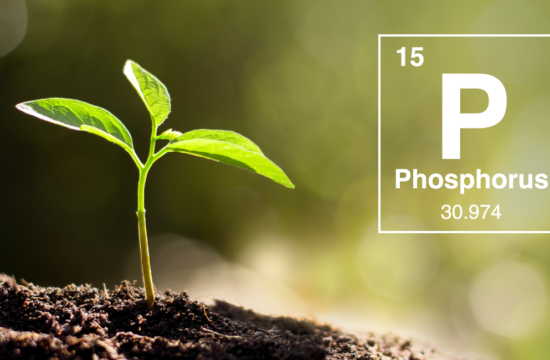You know Phosphorus is essential to the success of your crops. You also know how hard it can be to keep Phosphorus where it’s applied. Being one of the three necessary macronutrients vital to plant health (Nitrogen and Potassium being the other two), you want to see 100% nutrient intake when you spend time and money applying Phosphorus. But your investment, unfortunately, is up against a strong enemy: runoff. Phosphorus runoff can leave your crops with a fraction of what you applied, causing a number of costly issues.
So, what can you do? Can you reduce phosphorus runoff? Are you doomed to throw away time and money on your Phosphorus application efforts? Nope. Don’t worry — we’ve got answers.
What Does Phosphorus Do for Plants?
Plants require nutrients to survive and thrive just as humans do, and Phosphorus is high on their list of needs. It’s a nutrient critical for root development and stalk strength, and it helps crops mature earlier and more uniformly. It also increases resistance to plant disease, supports flowering, and increases seed production.
To get more specific, Phosphorus is a significant component to a plant’s DNA and RNA, which inform how a plant will grow and convert energy from the sun. It’s also found in ATP (adenosine triphosphate), which develops during photosynthesis. ATP drives all plant reactions once that plant takes in sunlight, and without it, a plant can’t sustain proper metabolic function.
In layman’s terms, Phosphorus aids in many essential functions for plants, and you want to make sure your crops are getting enough of it.
How Does Phosphorus Deficiency Affect Crop Growth?
A lack of Phosphorus is the starkest nutrient deficiency we see — once it’s visible. Early on in a plant’s development, it can be difficult to diagnose this type of nutrient deficiency. You’ll see general stunted growth in early development, but it’s not until discoloration begins that you can confidently point to Phosphorus deficiency.
At this stage, you’ll likely see the plant’s stem and leaf edges turn purple in color. Ever experienced purple corn syndrome? This relates back to ATP and the buildup of auxians that occurs when a plant is unable to redistribute sugar throughout itself. Once discoloration happens and deficiency is clear, however, it’s often too late to correct, meaning that’s it for your crop.
What Is Phosphorus Runoff, and Why Is It a Big Deal?
It would seem like the answer here is to apply more Phosphorus, right? More Phosphorus in the ground sounds good. The problem with this is that the issue isn’t the amount of Phosphorus in the soil, but rather how much is available to the plant. Adding more Phosphorus to the soil without increasing plant uptake only leads to further problems, like P runoff. When not absorbed by plants, Phosphorus sits in the soil. When hit with inevitable environmental forces like rain or wind erosion, or when a decent amount of snow melts, that Phosphorus will be carried away, often into water sources.
Phosphorus runoff is what we definitely don’t want, and you’re likely feeling pressure from regulatory organizations to mitigate this. High levels of Phosphorus impact oxygen levels in water bodies, leading to eutrophication. Eutrophication leads to a condition called hypoxia, or dead zones in water bodies. In these zones, life for fish and other aquatic animals is greatly threatened, and therefore our ecosystem is as well. Excess Phosphorus in waterways also creates the conditions for algae blooms, which not only disrupt wildlife, but can produce toxins harmful to humans that greatly affect air quality.
Enhance Crop Health and Yield
Transform how phosphorus nourishes your crops with AVAIL® T5. Our advanced polymer technology ensures more phosphorus remains available, enhancing nutrient uptake and environmental stewardship. Learn More and Explore!
How to Add Phosphorus to Soil
So, what’s the solution? How do we add Phosphorus to soil that’s actually available to plants while also addressing how to reduce Phosphorus runoff? More Phosphorus making it into your plants means less is available to be carried away, so how do we make that happen? A solid strategy is the combination of a reliable fertilizer enhancer with efficient field practices, such as no-tilling to minimize soil erosion, and banding near seeds to reduce Phosphorus fixation in soil and increase uptake.
A fertilizer enhancer, like AVAIL® from Verdesian Life Sciences, is proven to make more Phosphorus available to plants by up to 45%, regardless of source or timing. Positively charged elements like Calcium, Magnesium, Aluminum, and Iron can cause Phosphorus to become fixed in the soil. AVAIL slows fixation by temporarily binding with these elements, making your phosphate fertilizer more soluble and increasing the opportunity for root interception.
More available Phosphorus allows for rapid and earlier growth, healthier crops, and a stronger yield potential. That means you’re not throwing away money and time applying Phosphorus only to have your crops be able to use just a quarter of it. AVAIL® T5 Phosphorus Fertilizer Enhancer uses new patented polymer technology to further reduce fixation of applied Phosphorus and allows you to get more plant uptake for your investment.
We also must consider how to improve our operations and maximize fertilizer application. The 4R Nutrient Stewardship framework offers a win-win for farmers and the environment built around properly managing fertilizers. This framework suggests a formula of the right fertilizer source at the right rate and time and in the right place, which adheres to fertilizer best management practices (BMPs). Another important aspect to the discussion of proper management is the usage of cover crops to enhance soil, a major player in nutrient use efficiency.
How to Reduce Phosphorus Loss in Runoff
Wherever you’re ready to begin, now is the time to assess where you can decrease Phosphorus runoff and increase uptake. Not only do you want to see stronger crop yields and a greater return on investment, but further regulations for farmers aren’t far off when it comes to runoff. It’s time for farmers to take more innovative approaches to nutrient use efficiency and P runoff prevention, both to our benefit and the environment. Utilizing a quality fertilizer enhancer like AVAIL to increase Phosphorus uptake is a powerful tool in this strategy. To learn more about AVAIL, call 800-868-6446, or contact your Verdesian Life Sciences account manager.
- Keep a perimeter of buffer zones around water sources. Before they reach streams or lakes, setback regions filter away soluble phosphorus and degraded soil particles.
- Phosphorus should be applied to fields that need it for agronomic reasons. Yields will rise when phosphorus is administered to fields that test poorly. Less erosion and runoff may result from increased plant productivity.
- Use phosphorus sources that can be applied topically when runoff is uncertain. In the spring, when rainfall is most frequent and soils are frequently saturated with water, runoff is most likely to occur.
- Applying phosphorus sources topically to soils that are frozen, covered in snow, or wet is not advised. Under these circumstances, manure application is prohibited by laws governing water quality.
- Use crop selection and soil conservation techniques.
- Find fields with a high risk of phosphorus loss by using the phosphorus index.
- In tilled environments, apply sources of phosphorus beneath the surface. This only works if adding phosphorus does not substantially increase erosion.


